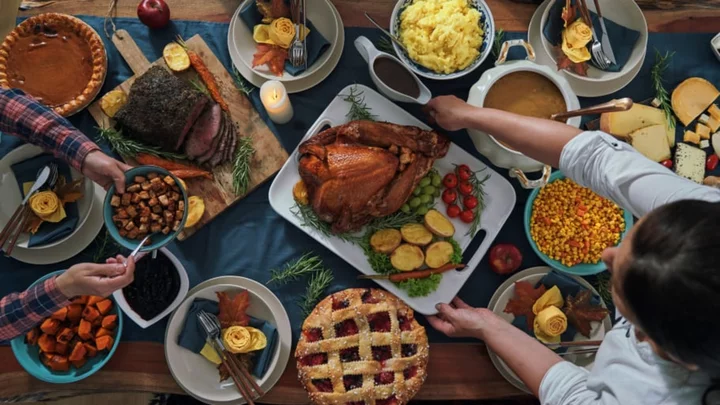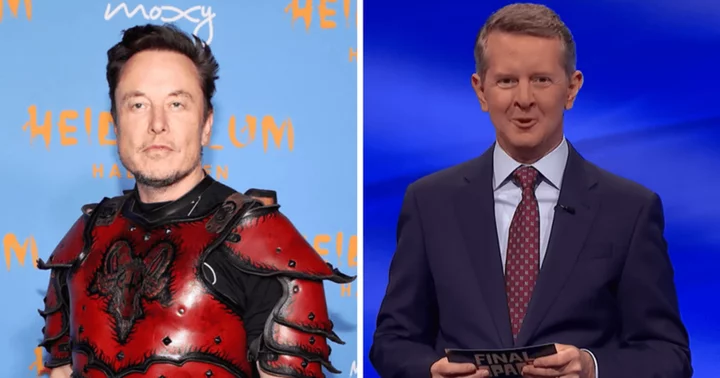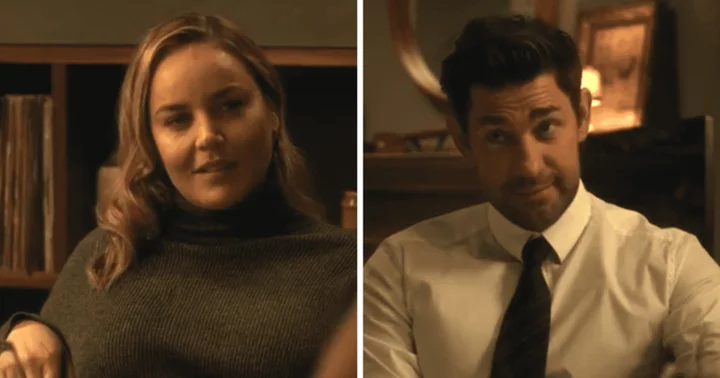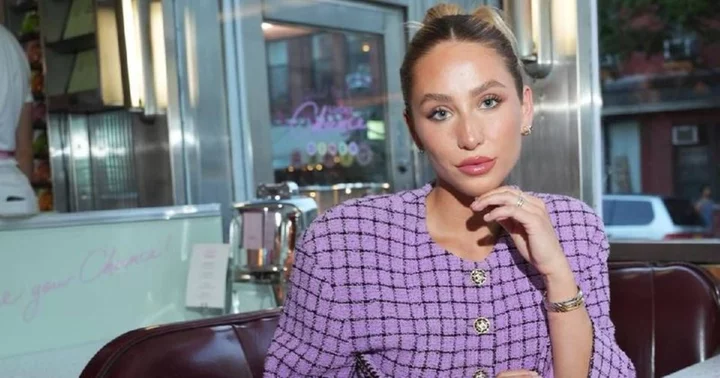While you’re gathering with loved ones this Thanksgiving—whether in person or over Zoom—you may find yourself making small talk family you haven't seen in a while. These 20 facts are sure to keep them fascinated until it’s time for the feast to begin.
1. There’s a connection between Thanksgiving and “Mary Had a Little Lamb.”
Writer Sarah Josepha Hale is credited with the 1830 poem “Mary’s Lamb,” which was eventually turned into the famous children’s song. (Whether she was behind the entire poem is still debated.) But although the tune has been a childhood favorite for well over a century, it’s arguably not even Hale’s most important contribution to the United States. As a native of New Hampshire, Hale had grown up with Thanksgiving festivities and was dismayed the holiday wasn't federally recognized. When she became editor of Godey's Lady's Book, she used her platform to write editorials and articles about the celebration, and also lobbied the government to declare an official holiday.
Hale used the outbreak of the Civil War to push even harder for a national day of Thanksgiving, thinking that setting aside one day for the entire country “would be of great advantage, socially, nationally, [and] religiously.” Abraham Lincoln agreed, and in 1863 he released an official proclamation that made Thanksgiving the final Thursday in November.
2. Not everyone thought Thanksgiving was a great idea.
When Lincoln declared the national holiday again in 1864, a Confederate editorialist from Richmond took the opportunity to insult both the Yankees and the recently re-elected Lincoln, saying: “This is an annual custom of that people, heretofore celebrated with devout oblations to themselves of pumpkin pie and roast turkey.”
3. For a short time, “Franksgiving” existed.
With only two exceptions, later presidents would follow Lincoln’s tradition of declaring the final Thursday in November Thanksgiving—until 1939, when Franklin Delano Roosevelt bumped it up a week in response to pressure from American retailers. Many people don't start holiday shopping until after Thanksgiving, so when the final Thursday coincided with the last day of the month, it cut the holiday shopping season—and sales—short. Though the calendar change made retailers happy, it angered FDR’s opponents. Conservative states refused to acknowledge the holiday they referred to as “Franksgiving,” continuing to give thanks on the last Thursday of the month. The split continued until a compromise was reached, and FDR signed legislation that made the fourth Thursday official.
4. Thomas Jefferson wasn’t a fan of Thanksgiving.
Until Lincoln standardized the date and tradition of Thanksgiving proclamations, presidents were far more haphazard in declaring it. George Washington issued Thanksgiving proclamations and John Adams issued proclamations for fasting and prayer. But Thomas Jefferson didn’t. At the time, Thanksgiving was very closely tied with religion and prayer, and Jefferson was a staunch supporter of the separation of church and state. In a letter to Reverend Samuel Miller in 1808, Jefferson wrote:
“I consider the government of the United States as interdicted by the Constitution from intermeddling with religious institutions, their doctrines, discipline, or exercises ... Certainly no power to prescribe any religious exercise, or to assume authority in religious discipline, has been delegated to the general government. ... But it is only proposed that I should recommend, not prescribe a day of fasting and prayer. That is, that I should indirectly assume to the United States an authority over religious exercises, which the Constitution has directly precluded them from ... civil powers alone have been given to the President of the United States and no authority to direct the religious exercises of his constituents.”
5. The first Thanksgiving feast looked very different from what we’re used to.
There was no cranberry sauce, no mashed potatoes, no sweet potatoes—and possibly no turkey. Some historical documents that recorded that first Thanksgiving have survived, so we know the Wampanoag brought deer. Wild turkey may have been part of the menu, but certainly not a focus or a centerpiece like it is today. Instead, they likely dined on passenger pigeons, swan, eel, lobster, clams, and mussels. Side dishes may have included corn, beans, and vegetables like turnips and squash.
6. There were no balloons at the first Macy’s Thanksgiving Day Parade.
The 40-to-75-foot brightly colored character balloons are a hallmark of the Macy's Thanksgiving Day Parade these days, but when the parade debuted in 1924, there was not a single balloon in sight. Instead, there were nursery rhyme-themed floats, a visit from Santa Claus, and real animals borrowed from the Central Park Zoo. The first character balloon—Felix the Cat—was introduced in 1927. The next year, newspapers announced that the helium-filled balloons would be released at the end of the parade. They were fitted with a special release valve so that around a week later they would come back to the ground and members of the public could send them to Macy’s for a reward.
7. To promote his state as the birthplace of Thanksgiving, a senator appeared on The Tonight Show dressed like a pilgrim.
Not everyone believes the first Thanksgiving took place in Plymouth. On December 4, 1619, a ship called the Margaret landed in what is now Virginia. Captain John Woodlief documented the day as one that must be celebrated “yearly and perpetually kept holy as a day of Thanksgiving to Almighty God”—and the settlers did, until many of them were slaughtered by the Powhatan in 1622. More than 300 years later, Virginia Senator John J. Wicker, Jr. spent much of the 1960s pushing his state as the birthplace of the first Thanksgiving, even appearing on The Tonight Show dressed as a pilgrim.
8. The Turducken’s history goes beyond Thanksgiving.
John Madden may have popularized the practice of stuffing a chicken into a duck and the duck into a turkey. But he certainly didn’t invent the idea of meat nesting dolls. The practice goes all the way back to at least 1774, when an edition of the book The Art of Cookery documented a “Yorkshire Christmas Pie” that involved stuffing pigeon, partridge, fowl, and goose into a turkey. Even more elaborate examples followed, including an 1807 creation called the “roast without equal” by Alexandre Balthazar Laurent Grimod de La Reynière; it included up to 17 different birds. The tradition eventually found its way to New Orleans, which is where Madden enjoyed his first turducken experience. “It smelled and looked so good,” Madden told The New York Times in 2002. “I didn’t have any plates or silverware or anything, and I just started eating it with my hands.” He began promoting the dish on-air, and the legend was born.
9. You probably can’t carve your Thanksgiving turkey as fast as Paul Kelly.
Kelly, a British turkey producer, is the Guinness World Record holder, with a warp-speed time of 3 minutes and 19.47 seconds. He also holds the turkey plucking record, besting even Gordon Ramsay: Kelly plucked three birds in 11 minutes, 30.16 seconds, while Ramsay came in a close second at 11 minutes, 31.78 seconds.
10. Thanksgiving Eve is one of the biggest drinking nights of the year.
Forget New Year’s Eve. According to the Wall Street Journal, “Blackout Wednesday” is the top drunk-driving night in many parts of the United States. The unfortunate phenomenon is likely due to college students (and other people who are home for the holidays) catching up with old friends the night before their family gatherings. In 2012, Mothers Against Drunk Driving reported that there are more drunk driving deaths at Thanksgiving than at Christmas.
11. “Jingle Bells” was originally a Thanksgiving song.
We may associate the cheerful song with Christmas these days, but when James Lord Pierpont wrote it in the mid-19th century, he likely intended it to be sung at Thanksgiving. The tune was originally called “One Horse Open Sleigh.” While the transition from one holiday to the other is a little fuzzy, one thing's for sure—“Jingle Bells” was firmly in the Christmas lineup by December 16, 1965, when astronauts Wally Schirra and Thomas Stafford played it on a harmonica while in orbit on Gemini 6, making it the first song played in outer space. The pranksters launched into the song after announcing that they had spotted a UFO of some sort.
12. Your family doesn’t want to talk politics at Thanksgiving dinner.
According to the 2017 Meyocks Thanksgiving Survey, 36 percent of people say politics should be avoided at Thanksgiving. If you have a relative who won't leave the subject alone, Lizzie Post, co-president of the Emily Post Institute and great-great-granddaughter of Emily Post, advises that it’s best to say, “I would really love to get away from politics at the Thanksgiving table this year.” If you find that you can’t help yourself, here are some old words of advice you can follow.
13. There’s a reason the Detroit Lions and the Dallas Cowboys always play football on Thanksgiving.
Spoiler alert: It was all a marketing scheme. When the Lions franchise moved to Detroit, Michigan, from Portsmouth, Ohio, in 1934, the citizens of Detroit weren't as excited to get a team as you might think—because they already had one, baseball's Detroit Tigers. In an attempt to get the city excited about its second team, owner George Richards came up with the idea of having a game on Thanksgiving. Because he was well-connected, Richards managed to convince NBC to broadcast the game on 94 stations across the U.S. It worked: The Lions filled the stadium to capacity and had to turn fans away at the gate. When the Dallas Cowboys picked up on the marketing scheme in 1966, fans broke the attendance record, and both teams have upheld the Turkey Day tradition nearly every year since.
14. The way we’ve depicted pilgrims is all wrong.
The black outfits, white collars, and buckled hats aren’t accurate. The actual pilgrims wore trousers, shirts, and dresses of various colors. Women sported colors like red, earthy green, brown, blue, violet, and gray. Men preferred white, beige, earthy green, brown, and black, but we also have evidence that one of the dlders, William Brewster, wore a red vest and a purple vest. The way the Native Americans are depicted is also misleading: “[They] certainly didn't go around in the chilly New England autumn half-naked,” said Laurence Pizer, the former director of Pilgrim Hall Museum in Plymouth, Massachusetts.
15. “Unthanksgiving” is celebrated at Alcatraz Island.
Every year, Indigenous people and their supporters gather at Alcatraz for a sunrise service where they give thanks for the survival of their people. The event was originally founded in 1975, partially in response to the story we're told about Pilgrims and Indigenous people living in harmony. "That's not what happened and we know it," says Andrea Carmen, the executive director of the International Indian Council. But over time, the group has adopted a different outlook. “The message of Unthanksgiving doesn't convey the true feeling of Indigenous people,” Carmen told the East Bay Express, “which is to give thanks every day for our survival, and the survival of the natural world, and the courage of our ancestors who fought and struggled and resisted to keep our culture alive for us.” Now more properly called the Indigenous Peoples Sunrise Ceremony, events include traditional dances and a prayer to the rising sun.
16. There’s a Thanksgiving wine.
Beaujolais Nouveau, a fruity red wine from the Beaujolais region of France, is annually released on the third Thursday of November, also known as Beaujolais Nouveau Day. The release date has become quite the event in Paris, where people have competed since the 1950s to see who can get the first bottles from Beaujolais to Paris. Marketers in the U.S. have used the November release date to pair the wine with the holiday, recommending Beaujolais as a terrific match for turkey.
17. Butterball isn’t the only turkey hotline you can call for help with your Thanksgiving feast.
The Butterball Turkey Talk-Line is famous for the calls it gets from uncertain cooks on Thanksgiving. But 1-800-BUTTERBALL isn't the only game in town. If you can't reach any of the 50-plus Butterball experts, you can also call the following numbers:
- The U.S. Department of Meat and Poultry Hotline: (888) 674-6854, open until 2 p.m. on Thanksgiving
- Honeysuckle White Turkey Line: (800) 810-6325 until noon on Thanksgiving
18. At one point, you could have called Julia Child for Thanksgiving dinner help.
Who needs a turkey hotline when you have Julia Child herself as a resource? During the 1970s and '80s, Child's number was publicly listed in the phone book, so enterprising home chefs took it upon themselves to dial her digits when they were having cooking troubles on Thanksgiving. Though she could have left her number unlisted or simply unplugged her phone on high-traffic days, Child refused. She always answered the phone, and, most of the time, she just told them whatever they needed to hear so they could chill out and enjoy their holidays, including to simply serve the turkey cold.
19. The most popular Thanksgiving dishes may surprise you.
According to Google’s 2017 list of the most popular Thanksgiving side dishes in every state, people’s dinner plates may look pretty different. While favorites like stuffing, green beans, sweet potatoes, and pecan pie make many lists, there are also a few surprises. If you live in South Dakota or Oregon, don't be surprised to find ambrosia salad on the table. Ohio is particularly fond of seven-layer salad, while sausage stuffing is on the menu in Connecticut. Arizona prefers pumpkin roll, while New York can't do without acorn squash.
20. Black Friday isn’t named for the day businesses got back into the black.
You've probably heard the tale that the massive amounts of shopping that take place on Black Friday puts businesses into the black, helping them make the financial flip from being in the red. In reality, the term dates back to the 1950s, when the Philadelphia police used it to refer to the day after Thanksgiving, which was also the day before the annual Army-Navy football game. Local retailers tried to take advantage of the crowds by having sales and calling it “Big Friday,” which resulted in utter madness in the stores. People used the mayhem to shoplift, so between the extra traffic, crowd control, and arrests, the police were not too happy about having to work some pretty serious overtime—hence the name. By the 1980s, the discounts and super sales started creeping across the nation.
A version of this story ran in 2017; it has been updated for 2023.
This article was originally published on www.mentalfloss.com as 20 Thanksgiving Facts to Liven Up Your Meal.









